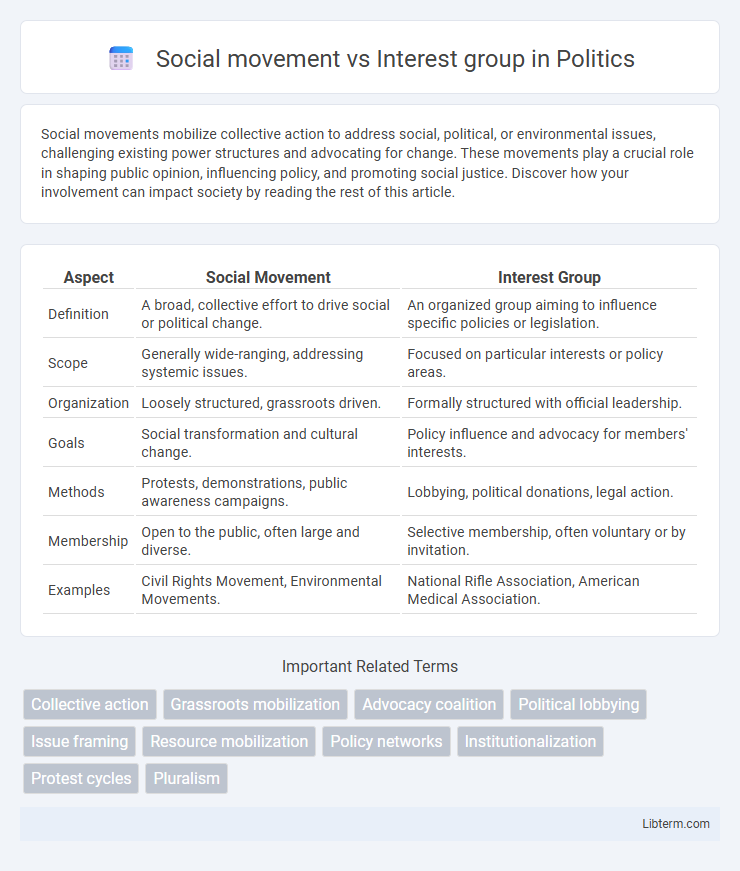Social movements mobilize collective action to address social, political, or environmental issues, challenging existing power structures and advocating for change. These movements play a crucial role in shaping public opinion, influencing policy, and promoting social justice. Discover how your involvement can impact society by reading the rest of this article.
Table of Comparison
| Aspect | Social Movement | Interest Group |
|---|---|---|
| Definition | A broad, collective effort to drive social or political change. | An organized group aiming to influence specific policies or legislation. |
| Scope | Generally wide-ranging, addressing systemic issues. | Focused on particular interests or policy areas. |
| Organization | Loosely structured, grassroots driven. | Formally structured with official leadership. |
| Goals | Social transformation and cultural change. | Policy influence and advocacy for members' interests. |
| Methods | Protests, demonstrations, public awareness campaigns. | Lobbying, political donations, legal action. |
| Membership | Open to the public, often large and diverse. | Selective membership, often voluntary or by invitation. |
| Examples | Civil Rights Movement, Environmental Movements. | National Rifle Association, American Medical Association. |
Defining Social Movements and Interest Groups
Social movements are collective, grassroots campaigns aiming for broad social change, often challenging existing norms and policies through sustained public activism. Interest groups consist of organized entities that seek to influence specific government policies and decisions by lobbying, advocacy, and building relationships with policymakers. While social movements generate widespread social momentum, interest groups operate through structured, strategic efforts to achieve targeted legislative or regulatory outcomes.
Key Characteristics of Social Movements
Social movements are large, organized groups that seek widespread social change through collective action and grassroots mobilization, often operating outside formal political institutions. They typically exhibit characteristics such as a shared identity among participants, a strong commitment to a cause, and the use of symbolic protests, demonstrations, and public campaigns to influence societal norms and policies. Unlike interest groups, which focus on specific policy issues through lobbying and institutional channels, social movements pursue broader transformative goals and rely heavily on mass participation and cultural shifts.
Core Features of Interest Groups
Interest groups are organized entities that seek to influence public policy by representing specific interests or causes, often using lobbying, advocacy, and public campaigns. Unlike social movements, which are broad, grassroots efforts aimed at societal change, interest groups have a structured membership, formal leadership, and clear policy goals. They focus on targeted political influence, utilizing resources such as research, expert testimony, and direct communication with policymakers to achieve legislative or regulatory outcomes.
Historical Origins and Development
Interest groups trace their origins to early American political history, emerging in the 19th century as organized entities seeking to influence government policy through lobbying and advocacy. Social movements developed from broader grassroots efforts in the 20th century, aiming to create widespread social change beyond formal political channels. While interest groups operate within established political frameworks, social movements often arise from collective dissatisfaction and seek to transform societal norms over time.
Goals and Motivations Compared
Social movements aim to create broad societal change by mobilizing large groups around shared values, often addressing systemic issues such as civil rights or environmental justice. Interest groups focus on influencing specific policies or legislation to benefit their members' particular interests, like trade associations lobbying for industry regulations. While social movements prioritize widespread cultural transformation, interest groups are motivated primarily by targeted, pragmatic objectives within the political system.
Organizational Structure and Leadership
Social movements typically have decentralized organizational structures with fluid leadership, allowing for grassroots participation and collective decision-making. Interest groups exhibit formal, hierarchical structures with established leadership roles, enabling strategic planning and consistent advocacy efforts. The leadership in social movements is often charismatic and emergent, whereas interest groups rely on professional leaders and paid staff to manage operations and lobbying activities.
Methods of Advocacy and Mobilization
Social movements employ widespread grassroots activism, public demonstrations, and symbolic actions to influence cultural norms and policy changes, often leveraging social media for rapid mobilization. Interest groups focus on targeted lobbying, fundraising, and expert testimony to persuade policymakers and secure specific legislative outcomes through formal political channels. Both utilize collective action, but social movements emphasize broad public engagement, whereas interest groups prioritize direct institutional influence.
Influence on Public Policy and Society
Social movements exert broad influence on public policy and society by mobilizing large-scale grassroots support and framing widespread cultural narratives that pressure policymakers for systemic change. Interest groups focus on targeted advocacy through lobbying, campaign contributions, and expert testimony to shape specific legislative outcomes and regulatory decisions. While social movements drive societal transformation and public awareness, interest groups secure direct policy benefits through established political channels.
Case Studies: Social Movements vs. Interest Groups
Social movements such as the Civil Rights Movement mobilize broad public support and aim to create systemic social change, whereas interest groups like the National Rifle Association focus on influencing specific policies through lobbying and political advocacy. Case studies reveal that social movements are often grassroots-driven and seek to reshape societal norms, while interest groups operate within institutional frameworks to advance particular interests. Comparative analysis of the Women's Suffrage Movement and environmental interest groups highlights differences in scope, strategies, and impact on policy outcomes.
Challenges and Future Trends
Social movements often face challenges related to sustaining momentum, mobilizing diverse participants, and influencing policy without formal structures, while interest groups grapple with maintaining member engagement, lobbying effectiveness, and adapting to regulatory changes. Future trends indicate increased digital activism for social movements, utilizing social media algorithms to expand reach and mobilization. Interest groups are expected to leverage data analytics and coalition-building strategies to enhance targeted advocacy and lobbying efforts.
Social movement Infographic

 libterm.com
libterm.com